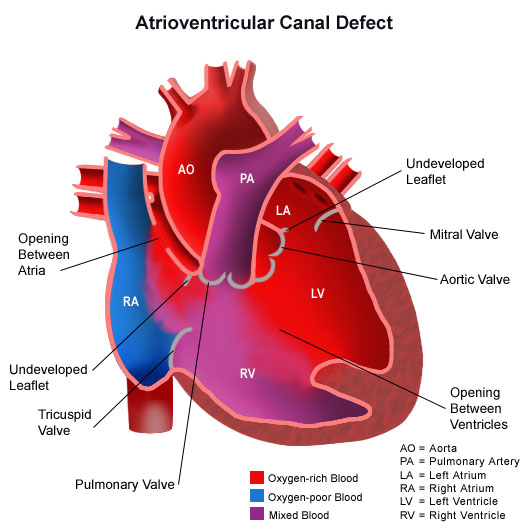Atrioventricular Canal Defect Causes, Symptoms, Diagnosis and Treatment

What Is Atrioventricular Canal Defect?
Atrioventricular canal defect is a combination of heart problems resulting in a defect in the center of the heart.
The condition occurs when there’s a hole between the heart’s chambers and problems with the valves that regulate blood flow in the heart.
It is caused by an abnormal or inadequate fusion of the superior and inferior endocardial cushions with the mid portion of the atrial septum and the muscular portion of the ventricular septum
Complications of atrioventricular canal defect can include:
- Enlargement of the heart. Increased blood flow through the heart forces it to work harder than normal, causing it to enlarge.
- Pulmonary hypertension. When the heart’s left ventricle weakens and can’t pump out enough blood, pressure builds and backs up through blood vessels in the lungs, causing high blood pressure in the lungs.
- Respiratory tract infections. Atrioventricular canal defect can cause recurrent bouts of lung infections.
- Heart failure. Untreated, atrioventricular canal defect usually results in the heart’s inability to pump enough blood to meet the body’s needs.
In partial atrioventricular canal defect: - There’s a hole in the wall (septum) that separates the upper chambers (atria) of the heart
- Often the valve between the upper and lower left chambers (mitral valve) also has a defect that causes it to leak (mitral valve regurgitation)
In complete atrioventricular canal defect: - There’s a large hole in the center of the heart where the walls between the atria and the lower chambers (ventricles) meet. Oxygen-rich and oxygen-poor blood mix through that hole.
- Instead of separate valves on the right and left, there’s one large valve between the upper and lower chambers.
- The abnormal valve leaks blood into the ventricles.
- The heart is forced to work harder and enlarges.
Causes Of Atrioventricular Canal Defect:
Atrioventricular canal defect occurs before birth when a baby’s heart is developing.
Some factors, such as Down syndrome, might increase the risk of atrioventricular canal defect. But the cause is generally unknown.
Risk factors Of Atrioventricular Canal Defect:
- German measles (rubella) or another viral illness during a mother’s early pregnancy
- Alcohol consumption during pregnancy
- Poorly controlled diabetes during pregnancy
- Smoking during pregnancy
- Certain medications taken during pregnancy
- Having a parent who had a congenital heart defect
Symptoms Of Atrioventricular Canal Defect:
The following signs and symptoms are exhibited:
- Complete atrioventricular canal defect
Difficulty breathing or rapid breathing
Wheezing
Fatigue
Lack of appetite
Poor weight gain
Pale skin color
Bluish discoloration of the lips and skin
Excessive sweating
Irregular or rapid heartbeat
Swelling in the legs, ankles and feet - Partial atrioventricular canal defect
Abnormal heartbeat (arrhythmia)
Shortness of breath
High blood pressure in the lungs (pulmonary hypertension)
Heart valve problems
Heart failure
Diagnosis Of Atrioventricular Canal Defect:
The following tests are conducted in order to diagnose atrioventricular canal defect:
- Electrocardiogram (ECG or EKG), look for patterns that indicate abnormal heart function.
- Echocardiogram, to reveal a hole in the heart and abnormal heart valves, as well as abnormal blood flow through the heart.
- Chest X-ray, which may show evidence of an enlarged heart.
- Cardiac catheterization.
Treatment Of Atrioventricular Canal Defect:
Surgery is needed to repair complete and partial atrioventricular canal defects. The procedure involves closing the hole in the septum with one or two patches. The patches stay in the heart permanently, becoming part of the septum as the heart’s lining grows over them.
Infants born with AVSD are generally in sufficient health to not require immediate corrective surgery. If surgery is not required immediately after birth, the newborn will be closely monitored for the next several months, and the operation held-off until the first signs of lung distress or heart failure.
By : Natural Health News




